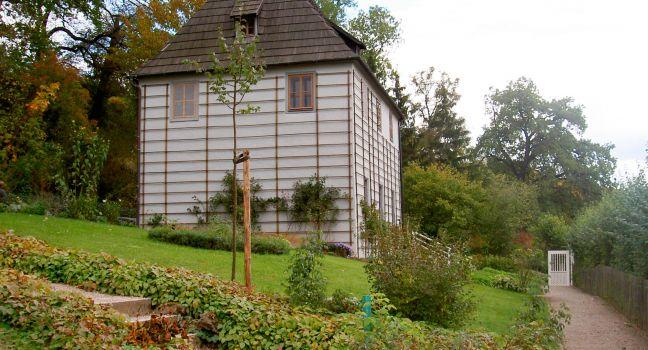Goethe Nationalmuseum
Goethe spent 57 years in Weimar, 47 of them in a house two blocks south of Theaterplatz that has since become a shrine attracting millions of visitors. The Goethe Nationalmuseum consists of several houses, including the
Get FREE email communications from Fodor's Travel, covering must-see travel destinations, expert trip planning advice, and travel inspiration to fuel your passion.
Sorry! We don't have any recommendations for Weimar right now.
We’ve compiled the best of the best in Weimar - browse our top choices for the top things to see or do during your stay.
Goethe spent 57 years in Weimar, 47 of them in a house two blocks south of Theaterplatz that has since become a shrine attracting millions of visitors. The Goethe Nationalmuseum consists of several houses, including the
When Walter Gropius founded the Staatliches Bauhaus (Bauhaus design school) in Weimar, it quickly became Germany's most influential and avant-garde design school, and it ushered in the era of modern architecture and design just before the start of World War II. Weimar's Bauhaus Museum is a modest, yet superb collection of the works of Gropius, Johannes Itten, and Henry van de Velde. The emphasis is on the early phase of the Bauhaus and displays the world's oldest collection of Bauhaus work. The Bauhaus is still alive today, and the museum tells the story of how our contemporary visions of our living environment have evolved and how they continue to develop.

Just north of Weimar, amid the natural beauty of the Ettersberg hills that once served as Goethe's inspiration, sits the blight of Buchenwald, one of the most infamous Nazi concentration camps. Fifty-six thousand men, women, and children from 35 countries met their deaths here through forced labor, starvation, disease, and gruesome medical experiments. Each is commemorated by a small stone placed on the outlines of the barracks, which have long since disappeared from the site, and by a massive memorial tower. In an especially cruel twist of fate, many liberated inmates returned to the camp as political prisoners of the Soviet occupation; they are remembered in the exhibit Soviet Special Camp #2. Besides exhibits, tours are available. To reach Buchenwald by public transportation, take Bus 6 (in the direction of Buchenwald, not Ettersburg), which leaves every 10 minutes from Goetheplatz in downtown Weimar. The one-way fare is €2.20

Goethe's first house in Weimar, the beloved Gartenhaus, is a modest country cottage where he spent many happy hours, wrote much poetry, and began his masterly classical drama Iphigenie. The house is set amid meadowlike parkland on the bank of the River Ilm. Goethe is said to have felt very close to nature here, and you can soak up the same rural atmosphere on footpaths along the peaceful little river.
This modest, cubical structure designed by Georg Muche for the 1923 Bauhaus exhibition is the first structure constructed using the Bauhaus’s new philosophy of functional modernity. The house is a small cubist structure comprised of concrete and stone walls with a flat roof and is a model for the Meisterhäuser in Dessau. All of the furniture was created specifically for the house by students of the Bauhaus design school.
Ask anyone where to find the Church of St. Peter and Paul and they will give you a confused look, but everyone knows the church associated with the philosopher Wilhelm Gottfried Herder. The Marktplatz's late-Gothic church has a large winged altar started by Lucas Cranach the Elder and finished by his son in 1555. The elder Cranach lived in a nearby house (two blocks east of Theaterplatz) during his last years, 1552–53. Its wide, imposing facade is richly decorated and bears the coat of arms of the Cranach family, but almost none of the gothic interior remains. The church also houses a modern art gallery.
Goethe and Schiller are buried in this leafy cemetery, where virtually every gravestone commemorates a famous citizen of Weimar. Their tombs are in the vault of the classical-style chapel. The cemetery is a short walk past Goethehaus and Wieland Platz.
The city is proud of eastern Germany's first museum exclusively devoted to contemporary art. The building, dating from 1869, houses an outstanding international collection of Realist, Impressionist, and art nouveau works. Early modernisim is at home in Weimar, and the works of the Weimar School of Painting and the avant-garde promoted by Harry Graf Kessler, from Claude Monet to Max Beckmann, help explain the contradictory and glamorous period at the end of the 19th century. In addition, it regularly presents international modern-art exhibitions.
This green-shuttered residence, part of the Goethe Nationalmuseum, is on a tree-shaded square not far from Goethe's house. Schiller and his family spent a happy, all-too-brief three years here (he died here in 1805). Schiller's study is tucked underneath the mansard roof, a cozy room dominated by his desk, where he probably completed Wilhelm Tell. Much of the remaining furniture and the collection of books were added later, although they all date from around Schiller's time.
A statue on this square, in front of the National Theater, shows Goethe, who was shorter in real life, placing a paternal hand on the shoulder of the younger Schiller.
Much of Weimar's greatness is owed to its patron, the widowed countess Anna Amalia, whose home, the Wittumspalais, is surprisingly modest. In the late 18th century the countess went talent hunting for cultural figures to decorate the glittering court her Saxon forebears had established. She discovered Goethe, and he served the countess as a counselor, advising her on financial matters and town design. Schiller followed, and he and Goethe became valued visitors to the countess's home. Within this exquisite baroque house you can see the drawing room in which she held soirées, complete with the original cherrywood table at which the company sat. The east wing of the house contains a small museum that's a fascinating memorial to those cultural gatherings.


 Sign up for Travel Tips & News
Sign up for Travel Tips & News
 Thank you for your interest!
Thank you for your interest!